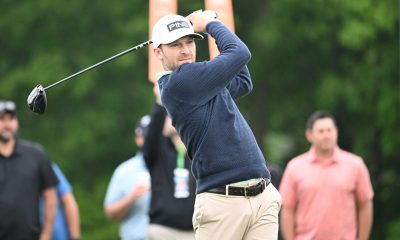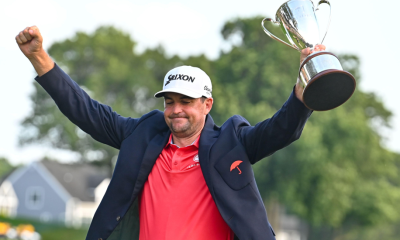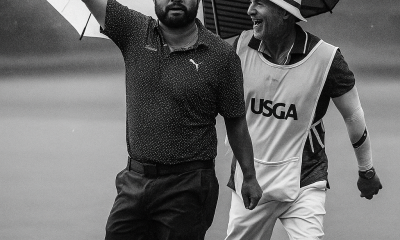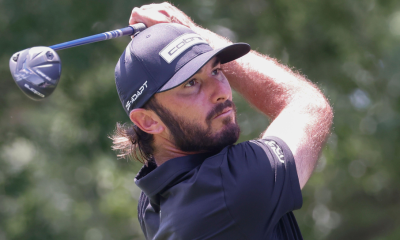Opinion & Analysis
Elliott: Why Brian Rolapp’s arrival could fix what ails the PGA Tour
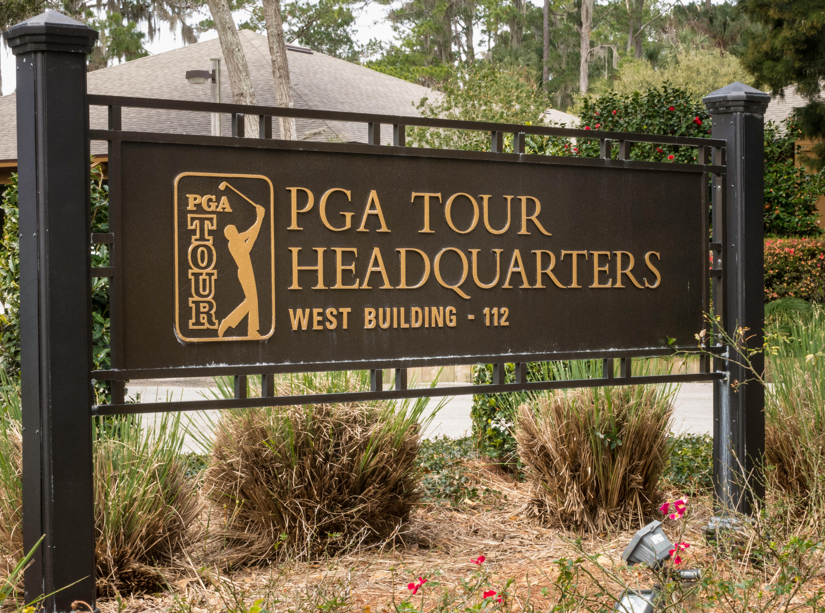
After nearly a decade of watching Jay Monahan navigate the PGA Tour through some of the most turbulent waters in professional golf’s history, the announcement that Brian Rolapp will take over as CEO in 2026 feels like the first genuinely hopeful moment the Tour has had in years. As someone who has spent decades in this industry, I’m cautiously optimistic that we might finally have found the right leader at the right time to address the mountain of issues that have been festering for far too long.
Giving Credit Where It’s Due
Don’t get me wrong—Monahan deserves credit for keeping the ship afloat during the LIV Golf storm. The man took more incoming fire than any commissioner in sports history, weathering everything from player defections to public criticism to that infamous framework agreement with the Saudi PIF that blindsided everyone, including his own players. But surviving a crisis and thriving beyond it are two entirely different skill sets, and that’s where Rolapp’s NFL pedigree becomes so intriguing.

The NFL Blueprint for Success
The NFL didn’t become America’s dominant sports entertainment juggernaut by accident. It got there through relentless innovation, strategic media partnerships, and an almost obsessive focus on the fan experience. Rolapp was instrumental in securing those landmark media deals with Amazon, Netflix, and YouTube that kept the NFL ahead of the curve while other sports leagues struggled with cord-cutting and changing viewing habits. If anyone understands how to navigate the modern sports media landscape, it’s the guy who helped the NFL secure over ten billion dollars per season in media rights.
Perfect Timing for Real Change
Here’s what excites me most about Rolapp’s appointment: he’s walking into a situation where the Tour finally has some momentum. The Signature Events are starting to deliver on their promise, with stars actually showing up and creating the kind of compelling storylines that make casual fans care. Viewership is up sixteen percent since the Farmers Insurance Open, and for the first time in years, it feels like the Tour is building something rather than just plugging holes in a sinking ship.
Fixing the Internal Structure
The timing couldn’t be better for tackling the Tour’s most pressing internal issues. The proposed changes for 2026—reducing field sizes, tightening exemption status, and creating cleaner pathways for emerging talent—are exactly the kind of structural reforms that should have happened years ago. When Patrick Fishburn can’t get into the Sony Open despite earning his card through the Korn Ferry Tour, while Ryan Moore gets in based on a 117th-place FedEx Cup finish, something is fundamentally broken. These changes will create more opportunities for rising talent while maintaining competitive integrity.
The Pace of Play Breakthrough
The pace of play problem, which reached its nadir when Dottie Pepper called out the Tour on live television during the Farmers, is finally getting the attention it deserves. The working group approach, involving players like Sam Burns and Adam Schenk, shows that the Tour is serious about finding solutions rather than just paying lip service to fan complaints. The fact that players like Collin Morikawa and Justin Thomas are now advocating for public release of pace-of-play statistics tells you everything you need to know about how the culture is shifting.
The LIV Elephant in the Room
But let’s be honest about the elephant in the room—or should I say, the LIV monkey that’s been wreaking havoc for four years now. Rolapp’s measured response about needing to “learn more” about the LIV situation before speaking shows the kind of diplomatic restraint that will be essential in any future negotiations. The reality is that fans want to see the best players competing against each other, period. Whether that happens through some kind of détente with the PIF or through the Tour continued evolution into a more compelling product, Rolapp’s media expertise will be crucial in crafting the right narrative.
The TV Problem Nobody Wants to Talk About
The external challenges are just as daunting as the internal ones. Television ratings may be trending upward, but the commercial load remains a massive barrier to fan engagement. Eighteen minutes of commercials per hour is simply unsustainable in an era where viewers have infinite entertainment options at their fingertips. Rolapp’s experience with innovative platforms like NFL+ suggests he understands that the future of sports consumption isn’t just about traditional broadcast television.
The Fan Forward initiative has already produced tangible improvements in telecasts, with more live golf shots and better coverage of cutline battles. But these are incremental changes when what’s needed is transformational thinking. The Tour needs to seriously consider whether premium events like the Signature series should command premium advertising rates that allow for fewer interruptions and a more immersive viewing experience.
The Right Leadership Philosophy
What gives me the most hope is that Rolapp seems to understand the delicate balance between honoring golf’s traditions and embracing necessary change. His open letter to Tour membership struck exactly the right tone: “Respect the past. Build the future.” That’s the kind of leadership philosophy that can unite a fractured membership while still pushing the Tour forward.
The Mountain of Challenges Ahead
The challenges ahead are enormous. Sponsor satisfaction is declining, with major partners like Wells Fargo and Honda expressing concerns about the Tour’s value proposition. International expansion remains largely theoretical rather than strategic. The FedEx Cup playoffs still feel like a manufactured drama that nobody can defend with a straight face. Equipment regulations continue to be ignored while courses become obsolete and the game becomes increasingly one-dimensional.
Cautious Optimism for the Future
But for the first time in years, I believe the Tour has the right person in place to tackle these issues systematically rather than reactively. Rolapp’s track record of building sustainable growth in a rapidly changing media landscape, combined with his collaborative approach and fresh perspective, could be exactly what professional golf needs.
The next two years will be crucial as Monahan transitions his responsibilities and Rolapp settles into his new role. If they can use this time to build on the current momentum while addressing the fundamental structural issues that have plagued the Tour, we might look back on this announcement as the moment when professional golf finally turned the corner.
The game deserves better than the chaos and uncertainty of the past few years. With Brian Rolapp at the helm, it just might get it.
PGA Professional Brendon Elliott is an award-winning coach and golf writer. You can check out his writing work and learn more about him by visiting BEAGOLFER.golf and OneMoreRollGolf.com. Each Monday, check out his regular column “The Starter” on RG.org.
Editor’s note: “My Take” is an ongoing series where Brendon shares his thoughts and opinions on various aspects of the game and industry. These are Brendon’s opinions and do not necessarily reflect those of GolfWRX, its staff, and its affiliates.
Opinion & Analysis
The 2 primary challenges golf equipment companies face

As the editor-in-chief of this website and an observer of the GolfWRX forums and other online golf equipment discourse for over a decade, I’m pretty well attuned to the grunts and grumbles of a significant portion of the golf equipment purchasing spectrum. And before you accuse me of lording above all in some digital ivory tower, I’d like to offer that I worked at golf courses (public and private) for years prior to picking up my pen, so I’m well-versed in the non-degenerate golf equipment consumers out there. I touched (green)grass (retail)!
Complaints about the ills of and related to the OEMs usually follow some version of: Product cycles are too short for real innovation, tour equipment isn’t the same as retail (which is largely not true, by the way), too much is invested in marketing and not enough in R&D, top staffer X hasn’t even put the new driver in play, so it’s obviously not superior to the previous generation, prices are too high, and on and on.
Without digging into the merits of any of these claims, which I believe are mostly red herrings, I’d like to bring into view of our rangefinder what I believe to be the two primary difficulties golf equipment companies face.
One: As Terry Koehler, back when he was the CEO of Ben Hogan, told me at the time of the Ft Worth irons launch, if you can’t regularly hit the golf ball in a coin-sized area in the middle of the face, there’s not a ton that iron technology can do for you. Now, this is less true now with respect to irons than when he said it, and is less and less true by degrees as the clubs get larger (utilities, fairways, hybrids, drivers), but there remains a great deal of golf equipment truth in that statement. Think about it — which is to say, in TL;DR fashion, get lessons from a qualified instructor who will teach you about the fundamentals of repeatable impact and how the golf swing works, not just offer band-aid fixes. If you can’t repeatably deliver the golf club to the golf ball in something resembling the manner it was designed for, how can you expect to be getting the most out of the club — put another way, the maximum value from your investment?
Similarly, game improvement equipment can only improve your game if you game it. In other words, get fit for the clubs you ought to be playing rather than filling the bag with the ones you wish you could hit or used to be able to hit. Of course, don’t do this if you don’t care about performance and just want to hit a forged blade while playing off an 18 handicap. That’s absolutely fine. There were plenty of members in clubs back in the day playing Hogan Apex or Mizuno MP-32 irons who had no business doing so from a ballstriking standpoint, but they enjoyed their look, feel, and complementary qualities to their Gatsby hats and cashmere sweaters. Do what brings you a measure of joy in this maddening game.
Now, the second issue. This is not a plea for non-conforming equipment; rather, it is a statement of fact. USGA/R&A limits on every facet of golf equipment are detrimental to golf equipment manufacturers. Sure, you know this, but do you think about it as it applies to almost every element of equipment? A 500cc driver would be inherently more forgiving than a 460cc, as one with a COR measurement in excess of 0.83. 50-inch shafts. Box grooves. And on and on.
Would fewer regulations be objectively bad for the game? Would this erode its soul? Fortunately, that’s beside the point of this exercise, which is merely to point out the facts. The fact, in this case, is that equipment restrictions and regulations are the slaughterbench of an abundance of innovation in the golf equipment space. Is this for the best? Well, now I’ve asked the question twice and might as well give a partial response, I guess my answer to that would be, “It depends on what type of golf you’re playing and who you’re playing it with.”
For my part, I don’t mind embarrassing myself with vintage blades and persimmons chasing after the quasi-spiritual elevation of a well-struck shot, but that’s just me. Plenty of folks don’t give a damn if their grooves are conforming. Plenty of folks think the folks in Liberty Corner ought to add a prison to the museum for such offences. And those are just a few of the considerations for the amateur game — which doesn’t get inside the gallery ropes of the pro game…
Different strokes in the game of golf, in my humble opinion.
Anyway, I believe equipment company engineers are genuinely trying to build better equipment year over year. The marketing departments are trying to find ways to make this equipment appeal to the broadest segment of the golf market possible. All of this against (1) the backdrop of — at least for now — firm product cycles. And golfers who, with their ~15 average handicap (men), for the most part, are not striping the golf ball like Tiger in his prime and seem to have less and less time year over year to practice and improve. (2) Regulations that massively restrict what they’re able to do…
That’s the landscape as I see it and the real headwinds for golf equipment companies. No doubt, there’s more I haven’t considered, but I think the previous is a better — and better faith — point of departure when formulating any serious commentary on the golf equipment world than some of the more cynical and conspiratorial takes I hear.
Agree? Disagree? Think I’m worthy of an Adam Hadwin-esque security guard tackle? Let me know in the comments.
@golfoncbs The infamous Adam Hadwin tackle ? #golf #fyp #canada #pgatour #adamhadwin ? Ghibli-style nostalgic waltz – MaSssuguMusic
Podcasts
Fore Love of Golf: Introducing a new club concept

Episode #16 brings us Cliff McKinney. Cliff is the founder of Old Charlie Golf Club, a new club, and concept, to be built in the Florida panhandle. The model is quite interesting and aims to make great, private golf more affordable. We hope you enjoy the show!
Opinion & Analysis
On Scottie Scheffler wondering ‘What’s the point of winning?’

Last week, I came across a reel from BBC Sport on Instagram featuring Scottie Scheffler speaking to the media ahead of The Open at Royal Portrush. In it, he shared that he often wonders what the point is of wanting to win tournaments so badly — especially when he knows, deep down, that it doesn’t lead to a truly fulfilling life.
View this post on Instagram
“Is it great to be able to win tournaments and to accomplish the things I have in the game of golf? Yeah, it brings tears to my eyes just to think about it because I’ve literally worked my entire life to be good at this sport,” Scheffler said. “To have that kind of sense of accomplishment, I think, is a pretty cool feeling. To get to live out your dreams is very special, but at the end of the day, I’m not out here to inspire the next generation of golfers. I’m not out here to inspire someone to be the best player in the world, because what’s the point?”
Ironically — or perhaps perfectly — he went on to win the claret jug.
That question — what’s the point of winning? — cuts straight to the heart of the human journey.
As someone who’s spent over two decades in the trenches of professional golf, and in deep study of the mental, emotional, and spiritual dimensions of the game, I see Scottie’s inner conflict as a sign of soul evolution in motion.
I came to golf late. I wasn’t a junior standout or college All-American. At 27, I left a steady corporate job to see if I could be on the PGA Tour starting as a 14-handicap, average-length hitter. Over the years, my journey has been defined less by trophies and more by the relentless effort to navigate the deeply inequitable and gated system of professional golf — an effort that ultimately turned inward and helped me evolve as both a golfer and a person.
One perspective that helped me make sense of this inner dissonance around competition and our culture’s tendency to overvalue winning is the idea of soul evolution.
The University of Virginia’s Division of Perceptual Studies has done extensive research on reincarnation, and Netflix’s Surviving Death (Episode 6) explores the topic, too. Whether you take it literally or metaphorically, the idea that we’re on a long arc of growth — from beginner to sage elder — offers a profound perspective.
If you accept the premise literally, then terms like “young soul” and “old soul” start to hold meaning. However, even if we set the word “soul” aside, it’s easy to see that different levels of life experience produce different worldviews.
Newer souls — or people in earlier stages of their development — may be curious and kind but still lack discernment or depth. There is a naivety, and they don’t yet question as deeply, tending to see things in black and white, partly because certainty feels safer than confronting the unknown.
As we gain more experience, we begin to experiment. We test limits. We chase extreme external goals — sometimes at the expense of health, relationships, or inner peace — still operating from hunger, ambition, and the fragility of the ego.
It’s a necessary stage, but often a turbulent and unfulfilling one.
David Duval fell off the map after reaching World No. 1. Bubba Watson had his own “Is this it?” moment with his caddie, Ted Scott, after winning the Masters.
In Aaron Rodgers: Enigma, reflecting on his 2011 Super Bowl win, Rodgers said:
“Now I’ve accomplished the only thing that I really, really wanted to do in my life. Now what? I was like, ‘Did I aim at the wrong thing? Did I spend too much time thinking about stuff that ultimately doesn’t give you true happiness?’”
Jim Carrey once said, “I think everybody should get rich and famous and do everything they ever dreamed of so they can see that it’s not the answer.”
Eventually, though, something shifts.
We begin to see in shades of gray. Winning, dominating, accumulating—these pursuits lose their shine. The rewards feel more fleeting. Living in a constant state of fight-or-flight makes us feel alive, yes, but not happy and joyful.
Compassion begins to replace ambition. Love, presence, and gratitude become more fulfilling than status, profits, or trophies. We crave balance over burnout. Collaboration over competition. Meaning over metrics.
Interestingly, if we zoom out, we can apply this same model to nations and cultures. Countries, like people, have a collective “soul stage” made up of the individuals within them.
Take the United States, for example. I’d place it as a mid-level soul: highly competitive and deeply driven, but still learning emotional maturity. Still uncomfortable with nuance. Still believing that more is always better. Despite its global wins, the U.S. currently ranks just 23rd in happiness (as of 2025). You might liken it to a gifted teenager—bold, eager, and ambitious, but angsty and still figuring out how to live well and in balance. As much as a parent wants to protect their child, sometimes the child has to make their own mistakes to truly grow.
So when Scottie Scheffler wonders what the point of winning is, I don’t see someone losing strength.
I see someone evolving.
He’s beginning to look beyond the leaderboard. Beyond metrics of success that carry a lower vibration. And yet, in a poetic twist, Scheffler did go on to win The Open. But that only reinforces the point: even at the pinnacle, the question remains. And if more of us in the golf and sports world — and in U.S. culture at large — started asking similar questions, we might discover that the more meaningful trophy isn’t about accumulating or beating others at all costs.
It’s about awakening and evolving to something more than winning could ever promise.


